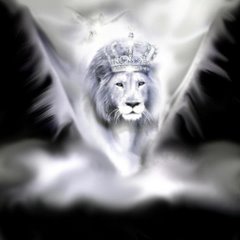
Speculation on the origins of dragons
It has been suggested that legends of dragons are based upon ordinary creatures coupled with common psychological tendencies amongst disparate groups of humans.
Some believe that the dragon may have had a real-life counterpart from which the various legends arose — typically dinosaurs or other archosaurs are mentioned as a possibility — but there is no physical evidence to support this claim, only alleged sightings collected by cryptozoologists. In a common variation of this hypothesis, giant lizards such as Megalania are substituted for the living dinosaurs. Some believe dragons are mental manifestations representing an assembly of inherent human fears of reptiles, teeth, claws, size and fire in combination. All of these hypotheses are widely considered to be pseudoscience.
Dinosaur and mammalian fossils were occasionally mistaken as the bones of dragons and other mythological creatures — a discovery in 300 BC in Wucheng, Sichuan, China, was labeled as such by Chang Qu.[5] It is unlikely, however, that these finds alone prompted the legends of such monsters, but they may have served to reinforce them.
It has also been suggested by proponents of catastrophism that comets or meteor showers gave rise to legends about fiery serpents in the sky. In Old English, comets were sometimes called fyrene dracan or fiery dragons. Volcanic eruptions may have also been responsible for reinforcing the belief in dragons, although instances in Europe and Asian countries were rare.
Asian Dragons
Naga or Nogo: Indonesian Dragon
Naga is a mythical animal from Indonesian mythology, and the myth encompasses almost all of the islands of Indonesia, especially those who were influenced heavily by Hindu culture. Like its Indian counterpart, it is considered as divine in nature, benevolent, and often associated with sacred mountains, forests, or certain parts of the sea.
In some parts of Indonesia, Dragon or Naga is depicted as a gigantic serpent with a golden crown on its forehead, and there is a persistent belief among certain peoples that Nagas are still alive in uncharted mountains, lakes and active volcanoes. In Java and Bali, dragons represent goodness, and gods send dragons to the earth in order to maintain the force of good and gave people prosperity. Some natives claimed sightings of this fabled beast, and considered as a good omen if someone happen to glimpse one of these animals, but misfortune if the dragons talked to them.
Cambodian myth also involves nagas. Cambodian myth has it that the Cambodian nation began with offspring of a naga and royal human.
Lóng (or Lung)Chinese Dragon
Lóng have a long, scaled serpentine form combined with the attributes of other animals; most (but not all) are wingless, and has four claws on each foot (five for the imperial emblem). They are rulers of the weather and water, and a symbol of power. They also carried their eggs which were thought to have been huge pearls in their hands.
Ryū: Japanese Dragon
Similar to Chinese and Korean dragons, with three claws instead of four. They are benevolent (with exceptions), associated with water, and may grant wishes; rare in Japanese mythology.
Rồng or Long: Vietnamese Dragon
These dragons' bodies curve lithely, in sine shape, with 12 sections, symbolising 12 months in the year. They are able to change the weather, and are responsible for crops. On the dragon's back are little, uninterrupted, regular fins. The head has a long mane, beard, prominent eyes, crest on nose, but no horns. The jaw is large and opened, with a long, thin tongue; they always keep a châu (gem/jewel) in their mouths (a symbol of humanity, nobility and knowledge).
Yong: Korean Dragons
A sky dragon, essentially the same as the Chinese lóng. Like the lóng, yong and the other Korean dragons are associated with water and weather.
yo
A hornless ocean dragon, sometimes equated with a sea serpent.
kyo
A mountain dragon.
Vyalee and Naga: Indian Dragon
There is some debate as to whether or not Vyalee is considered a dragon. It is found in temples and is correlated with the goddess Parvati. Naga is the main dragon of Indian and Hindu mythology. Nagas are a race of magical serpents that live below water. Their king wears a golden crown atop his head. The Nagas are associated with Buddha and mainly with Lord Vishnu and his incarnations (Dasavataras). When Krishna was a child, he wrestled with a Naga that was obstructing a lake.
This wraps up part 3 of the "Dragons" series. Part 4 will follow shortly and cover European and American dragons. Enjoy!
Peace & Soulz,
Bobby SharpeBobbySharpe.blogspot.com www.myspace.com/akuasharpe






No comments:
Post a Comment